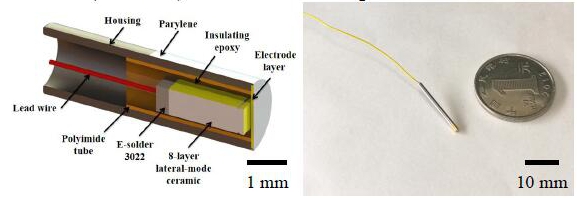Smaller Ultrasound Transducer Make Neuromodulation Perform Better
Date:30-03-2020 | 【Print】 【close】
Ultrasound neuromodulation holds promise as a non-invasive technique for neuromodulation of the central nervous system these years.
However, it’s difficult to perform multiple-target neurostimulation with existing large size of low-frequency transducers (less than 1 MHz), especially in small animals such as mice.
Researchers from the Shenzhen Institutes of Advanced Technology (SIAT) of the Chinese Academy of Sciences, proposed needle transducer with a total diameter of 1.65 mm, and the mice brain experiments showed that it’s useful for ultrasound neurostimulation and multiple-target stimulation.
This low-frequency ultrasound needle transducer was based on the multi-layer lateral-mode coupling method, with a miniature aperture of 0.6 mm × 0.6 mm and a thickness of 1.65 mm.
Researchers carried out the transcranial performance measurement by using an ex vivo mouse skull, the ultrasound beam showed no attenuation and low shift through the mouse skull.
They also constructed the ultrasound stimulus system to simultaneously stimulate two areas, M2 and V1 (the motor cortex and the visual cortex), of the mouse brain in vivo to detect the c-Fos expression, which was used as a marker of neuronal activity.
The percentage of c-Fos-expressed cells of the ultrasound-stimulated group was higher than that of the sham group, which indicated that this needle transducer would be effective for multi-target stimulation in mice.
Compared with the general ultrasound transducer, this multi-target stimulation transducer has significant advantages such as small size, low mass and can produces low-frequency and high acoustic intensity ultrasound.
This study has been published on the IEEE Transactions on Biomedical Engineering.

Figure. Design cross section and photograph of the 8-layer lateral-mode ceramic needle transducer.(Image by SIAT)
Media Contact:
ZHANG Xiaomin
Email: xm.zhang@siat.ac.cn